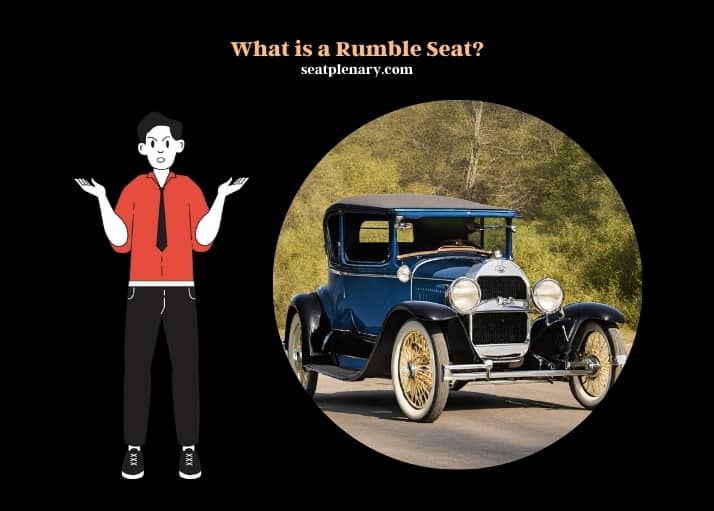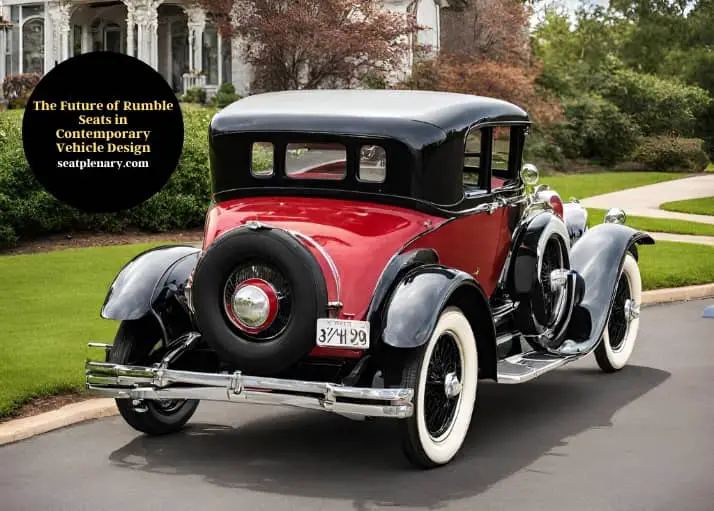A rumble seat refers to a foldable seat fitted into the rear of a vehicle, typically a coupe or roadster. It emerged in the early 20th century, offering an open-air seating experience.
This unique feature of vintage automobiles was more than just an additional seat; it was a symbol of the era’s innovation and style. Rumble seats were ingeniously designed to fold out from the car’s rear, providing space for one or two passengers. While they offered a thrilling ride experience, their practicality was limited by exposure to the elements and lack of safety features like seat belts or airbags.

The design of rumble seats varied across models and manufacturers. Some were simple and functional, while others boasted luxurious upholstery and trimmings, reflecting the car’s elegance. As closed-body cars became more prevalent, the rumble seat gradually faded from popularity, giving way to more secure and comfortable interior seating arrangements.
Today, rumble seats are a cherished feature in classic and vintage cars, evoking nostalgia and a sense of adventure. They remind us of a time when automotive design balanced practicality with a flair for excitement and novelty. For classic car enthusiasts, the rumble seat remains a treasured aspect of automotive history, symbolizing the innovation and charm of early 20th-century design.
Rumble Seat’s Historical Journey
The rumble seat, an iconic feature of early 20th-century automobiles, represents more than just a seating option; it’s a symbol of automotive evolution. Originating as a simple, foldable bench at the rear of cars, it was initially designed for chauffeurs. As cars became more common, the rumble seat evolved into a feature for passengers, offering an open-air experience.
Throughout the decades, the design of rumble seats underwent significant changes, reflecting broader shifts in automotive technology and design aesthetics. In the 1920s and 1930s, rumble seats were a luxury feature, often upholstered in fine leather with custom trimmings, showcasing the elegance and opulence of the era’s automobiles. They were more than just seats; they were statements of style and sophistication.
This evolution also mirrored societal changes. The rumble seat became a symbol of freedom and adventure, a testament to the roaring twenties’ spirit.
As car designs shifted towards closed-body models for safety and comfort, the rumble seat gradually faded from the mainstream automotive scene.
Design and Functionality of Rumble Seats
Rumble seats, while stylish, were designed with practicality and functionality in mind. Early versions were simple, fold-down seats, but as their popularity grew, so did their sophistication. By the 1930s, rumble seats featured more elaborate designs, including cushioned seats, armrests, and sometimes even windshields and footrests for added comfort.
Safety, however, was a concern. Rumble seats were exposed, without the safety features modern car seats have. Passengers were vulnerable to the elements and in the event of an accident. This lack of safety features, combined with advancements in car design, led to the decline of rumble seats in favor of more secure, interior seating.
Despite these drawbacks, the rumble seat remains a fascinating study in automotive design. It bridged the gap between functionality and luxury, offering a unique experience that modern cars can’t replicate. The design of rumble seats is a testament to the ingenuity and creativity of early automotive engineers and designers.
Rumble Seats in Media and Culture
Rumble seats have left an indelible mark on popular culture, symbolizing a bygone era of glamour and excitement. They frequently appeared in films and literature of the early 20th century, often associated with high-speed chases and romantic escapades. This portrayal helped cement their image as symbols of adventure and luxury.
In media, rumble seats were often used to depict a character’s wealth and social status. They were a common sight in movies set in the roaring twenties and the Great Gatsby era, adding a touch of class and nostalgia to the scenes. The rumble seat’s influence extended beyond the screen, impacting fashion and automotive design trends, as they became synonymous with elegance and adventure.
This cultural significance has endured, with rumble seats often featured in classic car shows and vintage rallies. They continue to captivate the imagination, reminding us of a time when cars were not just modes of transportation but symbols of style and freedom.
Rumble Seats vs. Modern Seating: A Comparative Analysis
| Feature | Rumble Seat | Modern Car Seat |
| Design | Open-air, rear-facing, foldable | Enclosed, forward-facing, fixed or adjustable |
| Safety | Minimal protection, no seatbelts | Advanced safety features, including seatbelts and airbags |
| Comfort | Basic cushioning, exposed to elements | Ergonomic design, climate control, superior cushioning |
| Capacity | Typically for one or two passengers | Designed for individual comfort and space |
The comparison between rumble seats and modern automotive seating highlights significant advancements in car design and passenger comfort. Modern seats are designed with ergonomics in mind, providing support and comfort for longer journeys. They also come equipped with advanced safety features like seatbelts and airbags, offering much greater protection than the exposed rumble seats.
Material technology has also evolved, with modern seats using durable, comfortable fabrics and materials that withstand wear and tear. This evolution reflects changing consumer preferences and a greater emphasis on safety and comfort in car design.
The Future of Rumble Seats in Contemporary Vehicle Design
The prospect of rumble seats in modern vehicle design intertwines nostalgia with innovation, presenting a unique blend of past and future. As interest in classic car designs sees a resurgence, the rumble seat could re-emerge, not just as a relic of the past but as a feature in contemporary vehicles. This revival, however, comes with its set of challenges and opportunities.

One of the primary challenges is integrating the rumble seat into modern vehicles while adhering to stringent safety standards. The original design, with its open-air concept and lack of safety features, doesn’t align with today’s safety regulations. Designers and engineers face the task of reimagining the rumble seat to meet current safety norms without losing its vintage charm. This could involve innovative use of materials, retractable designs for safety, and incorporation of modern safety features like reinforced structures and seatbelts.
Another aspect is the environmental consideration. Modern vehicles are increasingly moving towards sustainability, focusing on reducing emissions and improving fuel efficiency. The addition of a rumble seat needs to align with these environmental goals. Lightweight materials and aerodynamic designs could be key in integrating rumble seats without compromising vehicle efficiency.
The potential for rumble seats in contemporary design also opens up new opportunities. For luxury and custom car markets, the rumble seat could offer an exclusive feature, appealing to enthusiasts and collectors. It could also find a place in concept cars, showcasing a blend of retro design with futuristic technology.
Consumer interest in such a feature is a vital factor. The table below illustrates the growing curiosity and potential market for rumble seats in modern vehicle designs:
| Year | Consumer Interest in Classic Car Designs | Potential Market for Rumble Seat Integration |
| 2022 | Moderate | Low |
| 2023 | Increasing | Moderate |
| 2024 | High | High |
This data indicates a positive trend towards the acceptance and desire for retro features in modern vehicles. As consumer interest grows, the automotive industry might witness a unique fusion of past elegance with future technology, where rumble seats play a pivotal role in bridging these two worlds.
FAQs
How Were Rumble Seats Accessed?
Accessing a rumble seat was a unique aspect of its design. Typically, the seat was folded into the rear of the car, often hidden behind a hinged cover. To use it, one would unfold the seat, a process that varied depending on the car model. Some required lifting a panel or pulling a handle, while others had more complex mechanisms. This design made the rumble seat a hidden feature, contributing to its charm and novelty.
It also meant that accessing the seat could be less convenient, especially compared to modern car seats. The process was part of the experience, adding to the sense of adventure and exclusivity associated with riding in a rumble seat.
What Was the Capacity of a Rumble Seat?
The capacity of rumble seats varied, but they were generally designed to accommodate one or two passengers. The size and design depended on the vehicle model and the era in which it was manufactured. Early versions were smaller, often suitable for a single passenger, while later models, especially during the 1930s, were more spacious, accommodating two adults comfortably.
The limited capacity was a trade-off for the unique open-air experience these seats offered. It’s important to note that the rumble seat was an additional seating option, not intended to replace the main cabin’s seating capacity.
Did Rumble Seats Have Any Storage Space?
Rumble seats were not typically designed with storage space in mind. Their primary function was to provide additional seating, and as such, they utilized most of the available space for the seat itself. In some models, small storage areas might have been available under the seat or in the sides, but these were not common features.
The focus on providing a unique seating experience meant that practical aspects like storage were often overlooked in the design of rumble seats. This lack of storage space is one of the reasons rumble seats were more suited for short trips or leisure drives rather than practical, everyday use.
Were Rumble Seats Comfortable?
Comfort in rumble seats varied greatly depending on the car model and the era. Early rumble seats were quite basic, offering minimal cushioning and exposing passengers to the elements.
As they grew in popularity, manufacturers began to improve their design, adding better cushioning and sometimes even small windshields or covers for protection against wind and dust. Despite these improvements, rumble seats were never as comfortable as the main cabin seats, primarily due to their exposure to the outside environment and the lack of advanced ergonomic design that is common in modern car seats.
How Did Weather Affect Rumble Seat Use?
Weather had a significant impact on the use of rumble seats. Being open and exposed, rumble seats were ideal in fair weather conditions, offering an enjoyable and scenic ride.
In rain, snow, or extreme temperatures, using a rumble seat was impractical and often uncomfortable. Some models came with a foldable cover or a small windshield, but these provided limited protection. This weather dependency was one of the practical limitations of rumble seats, making them more of a novelty for pleasant weather outings rather than a reliable everyday seating option.
What Maintenance Did Rumble Seats Require?
Maintenance of rumble seats was relatively straightforward but important for preserving their functionality and appearance. The main aspects included regular cleaning, especially since they were exposed to the outdoor elements, and checking the hinges and folding mechanisms for smooth operation. Leather or fabric upholstery required care to prevent wear and tear.
Since rumble seats were often not used regularly, it was important to check them periodically to ensure they remained operational and free from rust or dust accumulation. Proper maintenance helped extend the life of these unique automotive features.
